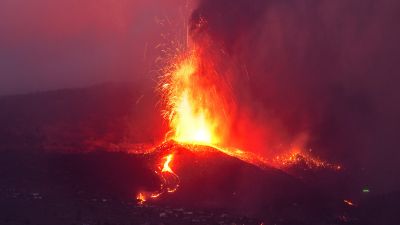La Palma volcano: Thousands evacuated and fears of toxic gases as lava flows towards sea

At least 1,000 people have been evacuated from a village on the Canary island of La Palma, as a wall of lava up to 12 metres high bore down on residents as the volcanic eruption continued.
The lava, which exceeds 1,000C (1,800F), is currently flowing towards the sea and there are fears that when the two meet it could cause explosions, trigger landslides and produce clouds of toxic gas.
The rivers of lava are now moving toward the island’s more populated coast and the Atlantic Ocean
Late on Tuesday, the village of Todoque was evacuated, meaning around 6,000 people across the Atlantic Island have now had to leave their homes.
The town of El Paso was also evacuated after a new fissure appeared some 900 metres from the ridge of the volcano. The lava stream has so far destroyed at least 183 homes along its path.
The eruption has forced the evacuation of 6,000 people
According to the Canary Islands Volcanology Institute, the first eruption occurred after 3pm on Sunday on a slope of the volcano in the Cumbre Vieja national park. Several earthquakes have been recorded on the island over the past few days that have triggered evacuations of local residents, as streams of lava were seen approaching homes.
Javier López, a Todoque resident, said his house for the past three decades appeared to be in the lava’s path.
He and his relatives had been staying at a friend’s house with the few documents, family memories and basic belongings they had been able to take when they were evacuated on Monday.
“I’ve put my whole life in a van,” Mr López said.
“This is probably going to be the last time I see my home,” he said.
“Or, in the best-case scenario, the house will remain isolated by the lava and inaccessible for who knows how long.”
Swimming pools evaporate from the heat of burning hot rocks tumbling in
Firefighting crews trying to save as many houses as possible from being entombed by lava worked nonstop overnight to open a trench to divert the lava flow.
Melisa Rodríguez, another Todoque resident, said that she was trying to stay positive and calm.
“It’s hard to think straight about what you want to save, but we are only allowed in for one hour and you don’t want to take longer because that would be taking time away from others,” she said.
Experts believe the volcanic eruption and its aftermath could last for up to 84 days.
Since last Sunday’s eruption, powerful rivers of unstoppable lava — up to six meters (nearly 20 feet) high — have swallowed up 320 buildings, mostly homes in the countryside.
The lava now covers 154 hectares, according to the Volcanology Institute.
Prompt evacuations have helped avoid any casualties from the eruption, though damage to homes, infrastructure and farmland is significant, officials say.
The volcano has also been spewing out between 8,000 and 10,500 tons of sulfur dioxide — which also affects the lungs — every day, the Volcanology Institute said.
The molten rock has also entombed banana groves, vineyards and crops of avocado and papaya.
Some irrigation networks have been lost, groundwater contaminated and roads blocked.
Pedro Sanchez, the Spanish Prime Minister, said it will be "weeks" until all of the damage is properly assessed, as steps were taken to declare a state of emergency in the region.
"Today, in the cabinet meeting, the government began all the steps to activate the procedure to declare the state of emergency in the region by the government, these will be long weeks so that we can assess all the damage," he told journalists at a press conference yesterday.
The rivers of lava are now moving toward the island’s more populated coast and the Atlantic Ocean, where they could cause new problems.